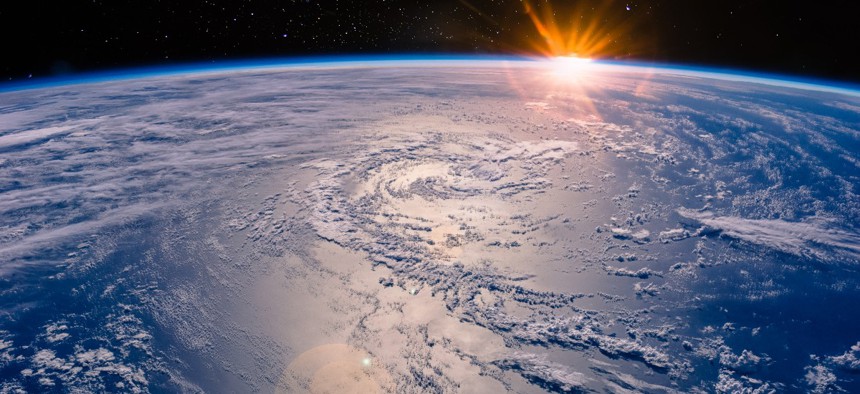New Satellite Will Allow First-Ever Observation of Nearly All of Earth’s Water

Elen11/Getty Images
NASA’s upcoming Surface Water and Ocean Topography satellite will provide a complete measurement every 21 days.
NASA is looking to launch its first satellite mission to observe Earth’s water in collaboration with France’s space agency, according to a media briefing held on Monday.
The Surface Water and Ocean Topography, or SWOT, satellite will use advanced radar interferometry technology to measure the height of water in lakes, rivers, reservoirs and oceans. Every 21 days, the satellite—which will cover the world between 78 degrees north and 78 degrees south—will have complete measurements of nearly all of Earth’s water—though this mission is focused solely on surface water.
This data will be important to examine water resources on land, track sea level changes, monitor coastal processes and observe ocean currents and eddies. In other words, it will help scientists track the movement of water around the world. According to speakers at the briefing, the SWOT mission will be critical to help understand climate change and the accelerating alterations in Earth’s water patterns, as well as the ocean’s role in climate change.
In particular, the SWOT satellite will measure and produce 2-D sea surface height data, using a technique called radar interferometry to collect this information.
“Conventional radar altimeter looks straight down, sampling one dimensional profile of water elevation,” Lee-Lueng Fu, SWOT project scientist at NASA’s JPL said. “The thrust of SWOT, however, is making two-dimensional measurement of the water elevation over a swath.”
Current “observations only revealed the two dimensional extendable water bodies. SWOT will add the third dimension of water elevation,” Fu said. “As my hydrology colleagues like to say, SWOT will provide them with a pair of 3-D glasses to study the dynamic movement of water bodies.”
According to Fu, previous methods required piecemealing the data, but SWOT will only take 21 days to sample Earth, without gaps.
“The adaptation under this high definition view will reveal ocean circulation never observed before that’s responsible for absorbing heat to protect us from excessive warming.” Fu said. “In the past, you don’t have this perspective of the elevation but—for the first time—SWOT will provide this third dimensional information. Therefore, we can study hydrology in a quantitative manner.”
The main payload for the mission is the Ka-band Radar Interferometer, or KaRIn, developed by NASA’s Jet Propulsion Laboratory.
“This new KaRIn instrument will enable us to collect data on the height of the Earth’s fresh and saltwater bodies over a very broad swath of the Earth at one time, at a very high resolution, much better than any other previous satellite that is flying now,” Parag Vaze, SWOT project manager at NASA’s JPL, said.
For example, the radar on the KaRIn system “sends electromagnetic pulses from one antenna that reflects off the surface of the earth and are received by both antennas at the same time,” Vaze said. “This provides a very precise measurement of the height using a triangulation technique called interferometry. That lets us create a 2-D map of the surface water.”
The approximately $1 billion mission is a collaboration between NASA and France’s space agency––Center National d’Études Spatiales––with assistance from the Canadian Space Agency and the UK Space Agency.
“SWOT is a game changer,” Tahani Amer, program executive of the Earth Science Division at NASA Headquarters, said.
The satellite consists of a payload module and spacecraft bus, with assembly led by NASA and CNES, respectively. The payload will have contributions from NASA, CNES and CSA, according to NASA’s website.
“It becomes evident that science, international cooperation is necessary to improve life on Earth,” Thierry Lafon, SWOT program manager at CNES, said. “Such an ambitious and challenging mission like SWOT could only be made possible by bringing together the skills of scientists and engineers to mutually enhance our ability to observe changes in the Earth’s water. Thanks to this international collaborative effort, we will be able to soon provide accurate weather forecasting, increase understanding of global climate change, as well as considerable social benefits.”
The SWOT satellite will be part of NASA’s Earth Observing System, orbiting approximately 500 miles from Earth at 17,000 miles per hour.
NASA plans to launch the satellite on Dec. 12 from the Vandenberg Space Force Base in California. SpaceX will provide launch services for SWOT using its Falcon 9 rocket; however, NASA’s launch services program at Kennedy Space Center will manage SpaceX’s launch service.
After launch, the first few months in orbit will be spent testing the satellite, conducting calibration and ensuring validation. The science portion of the mission will begin approximately six months after launch, with a planned mission length of three years.
The SWOT project has been in the works since approximately 2007, and data provided by the satellite will be free and publicly available.






